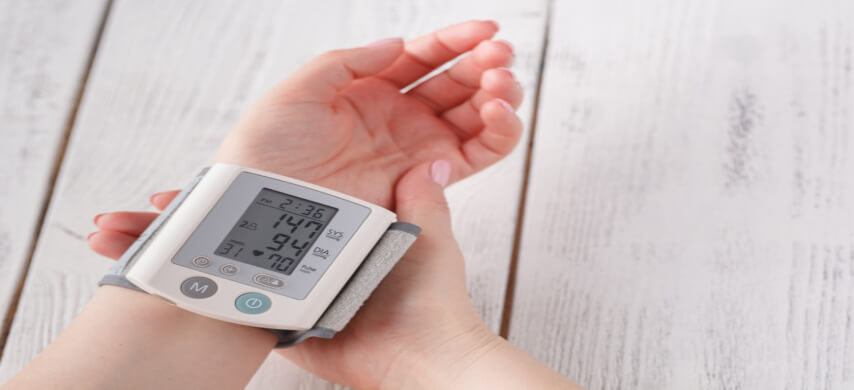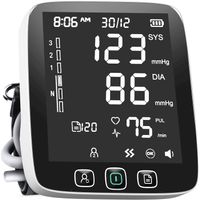How to Use a Wrist Blood Pressure Monitor
 Health & Personal Care
Health & Personal CareIn the quest for better health monitoring, wrist blood pressure monitors have emerged as convenient tools. Learning how to use them effectively is essential for accurate readings.
A study in the Hypertension Journal highlights the prevalence of incorrect usage of wrist blood pressure monitors at home, resulting in inaccurate readings. With that in mind, our team of experts got this guide to walk you through the simple steps of using a wrist blood pressure monitor at home. From positioning the pressure monitor correctly to understanding the importance of stillness during measurements, we'll cover all the basics.
Whether you're new to using these monitors or looking to improve the way you use them, this guide and tips will empower you to monitor your blood pressure accurately and take proactive steps toward maintaining your well-being.
What is a wrist blood pressure monitor?
A wrist blood pressure monitor is a compact medical device used to measure blood pressure levels. It is designed to be worn on the wrist, and it typically consists of a small display screen and a cuff that wraps around the wrist.
The cuff inflates to temporarily stop blood flow and then gradually releases it while measuring the pressure. This wrist blood device is often used as a convenient alternative to traditional upper arm monitors, providing a quick way to get blood pressure readings at home.
However, correct positioning and proper usage are crucial for accurate pressure readings.
When Might I Need a Wrist Blood Pressure Monitor?
You might consider using a wrist blood pressure monitor when convenience and ease of use are essential. If you have mobility challenges or find traditional upper arm cuffs uncomfortable, a wrist monitor offers a more accessible option.
It's also suitable for individuals with larger upper arms that may not fit standard cuffs properly.
If your doctor recommends frequent blood pressure monitoring due to hypertension (high blood pressure) or specific medical conditions, a wrist monitor allows you to track your pressure reading conveniently at home.
How To Position a Wrist Blood Pressure Monitor?
Here's how to properly position your body and wrist for accurate blood pressure measurements when using a wrist blood pressure monitor:
- Sit Comfortably: Find a quiet and comfortable place to sit down. Your back should be supported by a chair and your feet flat on the ground.
- Relax Your Arm: Rest your arm on a flat surface, like a table, with your palm facing upward. Keep your arm at the same level as your heart.
- Center Your Wrist: Position your wrist so that it's in line with your heart. This means your wrist should be at chest level, making it easier for the monitor to detect accurate readings.
- Wrist Placement: Slide the wrist blood pressure monitor onto your wrist. The bottom of the monitor's cuff should be approximately half an inch above your wrist bone.
- Secure Comfortably: Fasten the cuff around your wrist, ensuring a snug fit without it being too tight or too loose. You should be able to slide a finger between the cuff and your skin comfortably.
- Maintain Steady Arm: Keep your arm still and relaxed throughout the measurement process. Avoid tensing your muscles or talking during the reading.
How To Use a Wrist Blood Pressure Monitor
Follow our step-by-step guide on how to properly use a wrist blood pressure monitor for accurate blood pressure readings:
- Prepare the Monitor: Ensure your wrist blood pressure monitor is properly set up and ready for use. Make sure the device is charged or has fresh batteries.
- Find a Comfortable Spot: Sit down in a quiet and comfortable area. Rest your arm on a flat surface, such as a table, with your palm facing up.
- Locate the Correct Position: The monitor should be positioned at the same level as your heart. Align the monitor's wrist cuff with your heart by holding your arm close to your chest.
- Adjust the Cuff: Fasten the cuff snugly around your wrist, making sure it's neither too tight nor too loose. The bottom of the cuff should be about half an inch above your wrist bone.
- Proper Alignment: The monitor's display should be facing you, making it easy to read the results. Your wrist should be at the same level as your heart, so keep your arm supported on the table.
- Sit Still and Relax: Sit quietly without talking or moving during the reading. Take a few moments to relax and breathe normally before starting the measurement.
- Start the Measurement: Press the start button on the monitor. Keep your arm steady and avoid tensing your muscles. The monitor will begin inflating the cuff.
- Read the Results: Once the measurement is complete, the monitor will display your blood pressure readings. Take note of both the systolic (higher) and diastolic (lower) values.
- Record the Reading: If needed, record the readings in a notebook, app, or any tracking tool recommended by your healthcare provider.
- Repeat for Accuracy: For the most accurate readings, it's recommended to take two or three readings in a row, waiting a minute or two between measurements. Take the average of these readings for a more reliable result.
When Is the Best Time to Take Your Blood Pressure?
The best time to take your blood pressure is in the morning, before eating or drinking, and before taking any medications. It's recommended by doctors to measure your blood pressure twice a day for accuracy: once in the morning and before bedtime.
After exercising, eating, or drinking coffee, wait at least 30 minutes before taking a reading. Consistency in timing and a calm state contribute to more reliable results.
How to Read Blood Pressure Readings
Reading blood pressure measurements involves two elements: systolic and diastolic pressure. The systolic number, the higher of the two, represents the pressure in your arteries when the heart beats. Diastolic pressure, the lower number, is the pressure between heartbeats when your heart rests.
A normal blood pressure reading is around 120/80 mmHg. The systolic reading should ideally be below 120 mmHg, while the diastolic reading should be below 80 mmHg. Higher readings could indicate hypertension (high blood pressure), while lower readings might point to hypotension.
Understanding these numbers and their significance helps you track your cardiovascular health. Consult your doctor if your readings consistently fall outside the normal range or if you have concerns about your blood pressure.
Tips for Buying a Wrist Blood Pressure Monitor
When purchasing a wrist blood pressure monitor, several factors are crucial for an effective and accurate device
- Fit: Choose a monitor that fits comfortably on your wrist, ensuring proper positioning for accurate readings.
- Features: Look for essential features like irregular heartbeat detection, memory storage, and multiple user profiles.
- Screen Size: Opt for a monitor with a clear and easy-to-read screen, displaying your readings prominently.
- Battery Life: Consider a model with longer battery life to reduce frequent replacements.
- Budget: Set a budget that balances quality and affordability. High-end models might offer advanced features, but there are also reliable options within a budget.
- Validation: Ensure the monitor is clinically validated for accuracy.
- Ease of Use: Choose a device with user-friendly buttons and straightforward operation.
Best Blood Pressure Monitor:
According to our experts, the All-New LAZLE Blood Pressure Monitor is a standout choice for accurate health monitoring. With its large LED display and advanced technology, it provides precise readings that are easy to understand.
Its compact and lightweight design makes it convenient for on-the-go use. Offering safety and high quality, this monitor ensures 200 sets of memory storage, while the included batteries and carrying case add to its user-friendly appeal.
Best Seller:
The OMRON Bronze Blood Pressure Monitor is a popular choice for heart health management. Our experts find its one-touch design ensures easy usage while capturing accurate blood pressure readings and detecting irregular heartbeats or body movements during measurement.
With the capability to store up to 14 readings, it allows you to track and share essential information with caregivers or physicians. This monitor's premium features, accuracy, and reliability make it an optimal tool for maintaining heart health.
Best Blood Pressure Monitor with Smart App:
The Checkme BP2 Bluetooth Blood Pressure Monitor offers an exceptional home-use solution. Our experts find that with its user-friendly design, you can easily track your blood pressure data using the included app for iOS and Android.
The large comfortable cuff ensures accurate readings, while the ability to store unlimited data and share reports with a click makes monitoring your health effortless. Simple, reliable, and convenient, this monitor is a valuable addition to your health routine.
Best Premium Offer:
According to our experts, the Checkme BP2 WiFi Blood Pressure Monitor redefines premium health monitoring. Its compact design, easy usage, and large comfortable cuff ensure a hassle-free experience.
With Wi-Fi and Bluetooth connectivity, unlimited data syncing to the app, and AI-enabled analysis, tracking your blood pressure has never been simpler or more accurate. Your health routine can benefit from this exceptional device that seamlessly blends technology with a user-friendly design.
Incorporating a wrist blood pressure monitor into your health routine can empower you to take charge of your cardiovascular health. By following our guide, learning the correct techniques, and understanding the readings, you can track your blood pressure accurately and make informed decisions about your well-being.
Remember, regular monitoring and proper positioning are key to obtaining reliable results and maintaining a healthy lifestyle.




